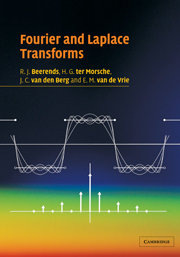Part 2 - Fourier series
Published online by Cambridge University Press: 05 June 2012
Summary
INTRODUCTION TO PART 2
The Fourier series that we will encounter in this part are a tool to analyse numerous problems in mathematics, in the natural sciences and in engineering. For this it is essential that periodic functions can be written as sums of infinitely many sine and cosine functions of different frequencies. Such sums are called Fourier series.
In chapter 3 we will examine how, for a given periodic function, a Fourier series can be obtained, and which properties it possesses. In chapter 4 the conditions will be established under which the Fourier series give an exact representation of the periodic functions. In the final chapter the theory of the Fourier series is used to analyse the behaviour of systems, as defined in chapter 1, and to solve differential equations. The description of the heat distribution in objects and of the vibrations of strings are among the oldest applications from which the theory of Fourier series has arisen. Together with the Fourier integrals for non-periodic functions from part 3, this theory as a whole is referred to as Fourier analysis.
Jean-Baptiste Joseph Fourier (1768 – 1830) was born in Auxerre, France, as the son of a tailor. He was educated by Benedictine monks at a school where, after finishing his studies, he became a mathematics teacher himself. In 1794 he went to Paris, where he became mathematics teacher at the Ecole Normale.
- Type
- Chapter
- Information
- Fourier and Laplace Transforms , pp. 57 - 59Publisher: Cambridge University PressPrint publication year: 2003
- 1
- Cited by

